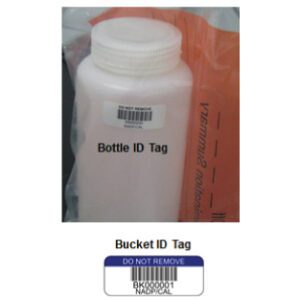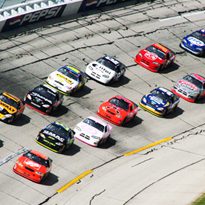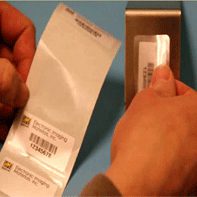
“Want me to give you a piggyback ride?” That is a fairly common question when it comes to children. But would you ever think that labels ride piggyback? Well they do, and it is almost as common as a child getting a piggyback ride. 
Piggyback labels ride on the back of other labels and move together – as double-layered labels. To begin―and to avoid confusion―we are not talking about two labels stacked one on top of the other like cash register receipt papers. What we are discussing is a 2-ply design using a top label (to be printed) with a layer of adhesive and liner, followed by another layer of adhesive and liner. The whole idea is that the bottom layer temporarily holds the top label.
These piggyback labels can be printed as single- or multi-part labels. The single-part construction is just one label but there are two ways it can be constructed: 1) The top piggyback label and liner are the same size as the second liner beneath it. This flush-cut design uses one die to cut the same size label through all layers and can often utilize existing tools thus giving you many size options. 2.) The second choice uses a nested design in which the top label and liner are a bit smaller than the bottom liner. This makes taking the top label off easier but is a bit more expensive because it requires two tools.
Multi-part piggyback labels have a single bottom liner that is topped with smaller label sections. The smaller labels can be removed―from say paperwork―and stuck somewhere permanently. This also lets you leave sections of the printed smaller labels behind as permanent reference information.
Now that we’ve got your interest peaked as to what piggyback labels are, let’s talk about some of their applications. You will be surprised at how many things you can do with piggyback labels. Almost every organization has to do paperwork, and one of the most common applications for piggyback labels is keeping paperwork organized and keeping document trails intact. Most of the time, one sheet of paperwork is associated with another sheet. This trend can span over many different sheets that are going to different places but still need to be linked to one another. With multipart piggyback labels, you can have the main label on the most important piece of paperwork and then use the other labels on all other pieces of paperwork. This will ensure that all paperwork is linked with the right thing, that nothing is miswritten, and that everything is organized. This is exactly what comes into play with a document trail. The same concept can be used for shipping receipts and packing boxes, payment receipts or other associated paperwork. Other popular applications include direct mail campaigns and coupons.
Piggyback labels usually come in direct thermal or thermal transfer paper and come ready for a converter like Electronic Imaging to simply die cut. If you are going to use the labels for paperwork this should be totally suitable.
However, perhaps you need a label to work in tough conditions. Or perhaps you have a certain label material that you use and like but need it in a piggyback format? We can engineer more durable or special label materials, by simply adding a second liner via a transfer adhesive. This opens up all sorts of application possibilities. You can have piggyback labels that resist chemicals, extreme temperatures and rough handling. You can have them made YOUR way and allows you all sorts of flexibility when ordering your piggyback labels.




